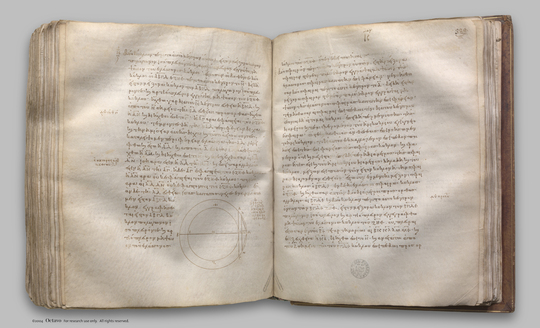index prev next | digilib folio 333

Given two circles about the same centre, to inscribe in the greater circle an equilateral polygon with an even number of sides which does not touch the lesser circle.
| Δύο κύκλων περὶ τὸ αὐτὸ κέντρον ὄντων εἰς τὸν μείζονα κύκλον πολύγωνον ἰσόπλευρόν τε καὶ ἀρτιόπλευρον ἐγγράψαι μὴ ψαῦον τοῦ ἐλάσσονος κύκλου. Ἔστωσαν οἱ δοθέντες δύο κύκλοι οἱ ΑΒΓΔ, ΕΖΗΘ περὶ τὸ αὐτὸ κέντρον τὸ Κ: δεῖ δὴ εἰς τὸν μείζονα κύκλον τὸν ΑΒΓΔ πολύγωνον ἰσόπλευρόν τε καὶ ἀρτιόπλευρον ἐγγράψαι μὴ ψαῦον τοῦ ΕΖΗΘ κύκλου. Ἤχθω γὰρ διὰ τοῦ Κ κέντρου εὐθεῖα ἡ ΒΚΔ, καὶ ἀπὸ τοῦ Η σημείου τῇ ΒΔ εὐθείᾳ πρὸς ὀρθὰς ἤχθω ἡ ΗΑ καὶ διήχθω ἐπὶ τὸ Γ: ἡ ΑΓ ἄρα ἐφάπτεται τοῦ ΕΖΗΘ κύκλου. τέμνοντες δὴ τὴν ΒΑΔ περιφέρειαν δίχα καὶ τὴν ἡμίσειαν αὐτῆς δίχα καὶ τοῦτο ἀεὶ ποιοῦντες καταλείψομεν περιφέρειαν ἐλάσσονα τῆς ΑΔ. λελείφθω, καὶ ἔστω ἡ ΛΔ, καὶ ἀπὸ τοῦ Λ ἐπὶ τὴν ΒΔ κάθετος ἤχθω ἡ ΛΜ καὶ διήχθω ἐπὶ τὸ Ν, καὶ ἐπεζεύχθωσαν αἱ ΛΔ, ΔΝ: ἴση ἄρα ἐστὶν ἡ ΛΔ τῇ ΔΝ. καὶ ἐπεὶ παράλληλός ἐστιν ἡ ΛΝ τῇ ΑΓ, ἡ δὲ ΑΓ ἐφάπτεται τοῦ ΕΖΗΘ κύκλου, ἡ ΛΝ ἄρα οὐκ ἐφάπτεται τοῦ ΕΖΗΘ κύκλου: πολλῷ ἄρα αἱ ΛΔ, ΔΝ οὐκ ἐφάπτονται τοῦ ΕΖΗΘ κύκλου. ἐὰν δὴ τῇ ΛΔ εὐθείᾳ ἴσας κατὰ τὸ συνεχὲς ἐναρμόσωμεν εἰς τὸν ΑΒΓΔ κύκλον, ἐγγραφήσεται εἰς τὸν ΑΒΓΔ κύκλον πολύγωνον ἰσόπλευρόν τε καὶ ἀρτιόπλευρον μὴ ψαῦον τοῦ ἐλάσσονος κύκλου τοῦ ΕΖΗΘ: ὅπερ ἔδει ποιῆσαι. | Given two circles about the same centre, to inscribe in the greater circle an equilateral polygon with an even number of sides which does not touch the lesser circle. Let ABCD, EFGH be the two given circles about the same centre K; thus it is required to inscribe in the greater circle ABCD an equilateral polygon with an even number of sides which does not touch the circle EFGH. For let the straight line BKD be drawn through the centre K, and from the point G let GA be drawn at right angles to the straight line BD and carried through to C; therefore AC touches the circle EFGH. [III. 16, Por.] Then, bisecting the circumference BAD, bisecting the half of it, and doing this continually, we shall leave a circumference less than AD. [X. 1] Let such be left, and let it be LD; from L let LM be drawn perpendicular to BD and carried through to N, and let LD, DN be joined; therefore LD is equal to DN. [III. 3, I. 4] Now, since LN is parallel to AC, and AC touches the circle EFGH, therefore LN does not touch the circle EFGH; therefore LD, DN are far from touching the circle EFGH. |